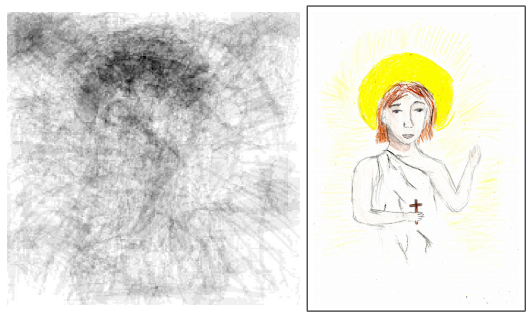The Machine-Vision Algorithm for Analyzing Children’s Drawings
Studying the psychology of children and the way it changes as they develop is a difficult business. One idea is that drawing plays a crucial role in children’s cognitive development, so drawings ought to provide a window into these changes.

Indeed, this is a significant focus of child psychologists. In particular, one area of interest is the way children’s drawings vary across cultures.
However, there is a problem with this kind of analysis. The cultural background of the researchers involved inevitably influences the way they analyze drawings, and this raises questions about the independence and usefulness of any results.
So finding a way to analyze children’s drawings objectively is an important goal.
Today, Ksenia Konyushkova at the Ecole Polytechnique Federale de Lausanne in Switzerland and a few pals say they have solved this problem using machine vision. They show how this technique can pick out patterns in children’s drawings in an independent way.
Their method is straightforward. The team used a machine-vision algorithm to create an “average” of the drawings by children. This then allows them to look at which parts of the page children prefer to draw on, the colors they use, the color intensity, and the complexity of the drawings. This is also allows the team to see how these things vary by age and location.
Konyushkova have a particular focus on the way children draw God. Their database consists of 2,389 drawings of God by children between the ages of 5 and 15. The children came from a variety of cultural backgrounds, being based in Switzerland, Japan, Romania, Russia, and the U.S. Their religions include Christian orthodoxy, Catholicism, Protestantism, and Buddhism.
The results show both the power and the limitations of this kind of science. The most impressive result is a clear demonstration that the complexity of a drawing changes as children get older.
“We observe that children tend to draw more complex scenes as they grow older,” say Konyushkova and co. “However, after some age (approximately 13 years old), they start drawing simple and abstract scenes again.” This is consistent with the consensus among child psychologists.
But the analysis of the role of religion is more problematic. One idea among researchers is that children tend to draw pictures of gods above the midline of piece of paper. They say this is because children think gods are somehow unworldly.
However, this work provides little insight into this idea. Konyushkova and co say that the machine vision analysis shows that average images from some parts of the world tend to be above the midline, for example, from Switzerland, Japan, and Russia. But images from other parts are centered, for example from the U.S. and Romania.
But more importantly, the team does not compare the images of gods with a control group of images that are not related to gods. That makes it hard to say anything about the role of God in the images. Perhaps children always draw above the midline in some parts of the world, regardless of the topic.
Konyushkova and co also look at the way children use the colors green and yellow. Their idea is that children use green to represent earthly objects such as the ground, and use yellow to represent supernatural objects like gods.
And on the face of it, the data backs this up. On average, yellow tends to appear in the center of the images while green appears at the bottom.
However, this is not good evidence for their hypothesis given that there is no control group of images. Perhaps yellow is more likely to appear in the middle of any child’s drawing, regardless of its topic. It’s not hard to think of a reason why this might be the case given that the sun is yellow and may be more likely to appear at the top of most children’s landscape drawings.
The team also discusses the way children in different cultures use yellow and why the differences arise. The image at the top left of this page shows the average distribution of yellow in images drawn in one part of Russia (specifically St. Petersburg). The top right image shows a typical drawing of god from this area.
The suggestion is that the idea of a halo plays a significant role in children’s drawing of god in this part of the world. And certainly, the distribution of yellow is different in the drawings from other parts of the world.
That’s a curious piece of research. On the one hand, it shows how machine-vision techniques have the power to reduce researchers’ influence in this kind of psychological research. Machine vision clearly moves the researcher one step away from the analysis.
However, it also shows that machine vision cannot make up for the poor design of experiments. The often stated truth of scientific work is: garbage in, garbage out. And no amount of machine intelligence will change that.
Ref: arxiv.org/abs/1511.03466 : God(s) Know(s): Developmental and Cross-Cultural Patterns in Children Drawings
Keep Reading
Most Popular
Large language models can do jaw-dropping things. But nobody knows exactly why.
And that's a problem. Figuring it out is one of the biggest scientific puzzles of our time and a crucial step towards controlling more powerful future models.
How scientists traced a mysterious covid case back to six toilets
When wastewater surveillance turns into a hunt for a single infected individual, the ethics get tricky.
The problem with plug-in hybrids? Their drivers.
Plug-in hybrids are often sold as a transition to EVs, but new data from Europe shows we’re still underestimating the emissions they produce.
Google DeepMind’s new generative model makes Super Mario–like games from scratch
Genie learns how to control games by watching hours and hours of video. It could help train next-gen robots too.
Stay connected
Get the latest updates from
MIT Technology Review
Discover special offers, top stories, upcoming events, and more.